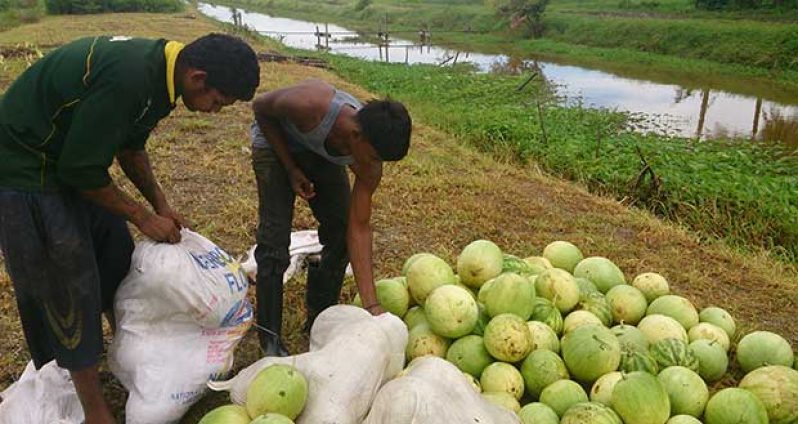In spite of the lucrative extractive sector, agriculture remains the main economic activity and provides employment for the majority of people in Guyana. Over 80 non-traditional crops such as bora, peppers, cabbage, pumpkin, cassava, citrus fruits, sweet potatoes, ochro and coconuts are produced locally- making Guyana a food-secure nation.

The major exports in this sector are dried coconuts, coconut water, watermelon, pineapple, limes, eddo, bora, saeme, mangoes, and wiri pepper. And, the value added commodities include pepper sauce, seasonings, achar, chips, jams, jellies, flours, dehydrated products, and coffee.
Importance of investments
Agriculture is done by private individuals and groups. Government creates policies and programmes and provides services to support their growth. The National Agricultural Research and Extension Insitute (NAREI) works closely with the vegetable producing communities including Mahaica, Mahaicony, Parika, Central Corentyne, Crabwood Creek, and Cane Grove.

There are different types of vegetables growers in these areas: Household gardeners (usually grow crops on a small scale for home consumption); urban vegetables growers use technology such as grow box, hydroponics, shaded cultivation to produce crops for the local market; and commercial vegetables farmers, who produce crops for the local and overseas markets.
By year-end, this sector is projected to grow by at least 5%. It has the potential to grow even further and be financially rewarding for those engaged. However, agriculture producers face a number of hurdles including low productivity, limited access to markets for their produce, lack of adequate risk management products and services and limited access to finances.
Many of these limitations could be overcome by farmers and other stakeholders treating agriculture as a business. Necessary financial injections, either from savings or financial services, while not a means to an end, are critical to fund:
1. Farm investments to boost productivity (Usage of equipment such as cassava planters and harvesters could increase cassava yield.).
2. Improve postharvest practices. For example, enhanced transport of produce such as bananas and pines could help reduce losses
3. Smooth household cash flow
4. Enable better access to markets
5. Promote better management of risks
Access to finances can also play an important role in climate change adaptation and increase the resilience of groups to climate change, thus contributing to long-term food security.
Business opportunities
There are numerous business opportunities in the non-traditional crop sector. They include: crop farming, agro-processing, seed and seedling production, business development (research on market demands), hydroponics, organic fertilizer production, shaded agriculture, production of animal feed, exporting, soils testing, and consulting.
With no fees attached, NAREI provides technical support to investors from the land preparation stage, spacing of crops, to post-harvest. The institute is not involved in marketing but from time to time assist to link producers to processors. About 80 percent of the persons who approach the National Agricultural Research and Extension Institute (NAREI) for advice on the establishment of an agribusiness go through with their investments.
NAREI has been encouraging farmers to get involved in shaded cultivation. Of course, it will require greater investment in the initial stage than that of open field cultivation. But, shaded cultivation is more profitable and allows year-round cultivation. The table below shows the cost of production for tomatoes under shaded cultivation on a land space of 60m²:
| Category | Details | Total cost G/$ |
| Materials | ||
| Seedlings | 300 | 3000 |
| Fertilizer (Pen manure) | 180kg@ $4 per kg | 720 |
| Trellising material | 300 sticks @ $100 each | 3000 |
| Agrochemicals | For pest control | 4000 |
| Labour | ||
| Land preparation | 1 man day@ 2000 | 2000 |
| Transplanting | 2 hrs @ $250 | 500 |
| Spraying | 2 man days @2000 | 4000 |
| Weeding | 6 man days @ 2000 | 8000 |
| Trellising | 1 man day @ 2000 | 2000 |
| Fertilizer application | 1hr @ 250 | 250 |
| Harvesting | 3 man days @2000 | 6000 |
| Total operational cost | 33,470 | |
Total Yield = 298 kg
RETURNS = TOTAL YIELD X SALE PRICE PER KG
=298 X $300 = $89400
PROFIT = RETURNS – TOTAL OPERATIONAL COST
= $ 89400 – 33470 =$ 55930
Profit/acre = G$3,728,666
The above clearly shows that shaded cultivation is indeed a worthwhile investment. However, farmers need to follow good farming practices as set out by NAREI to have a healthy productive farm.



.jpg)









